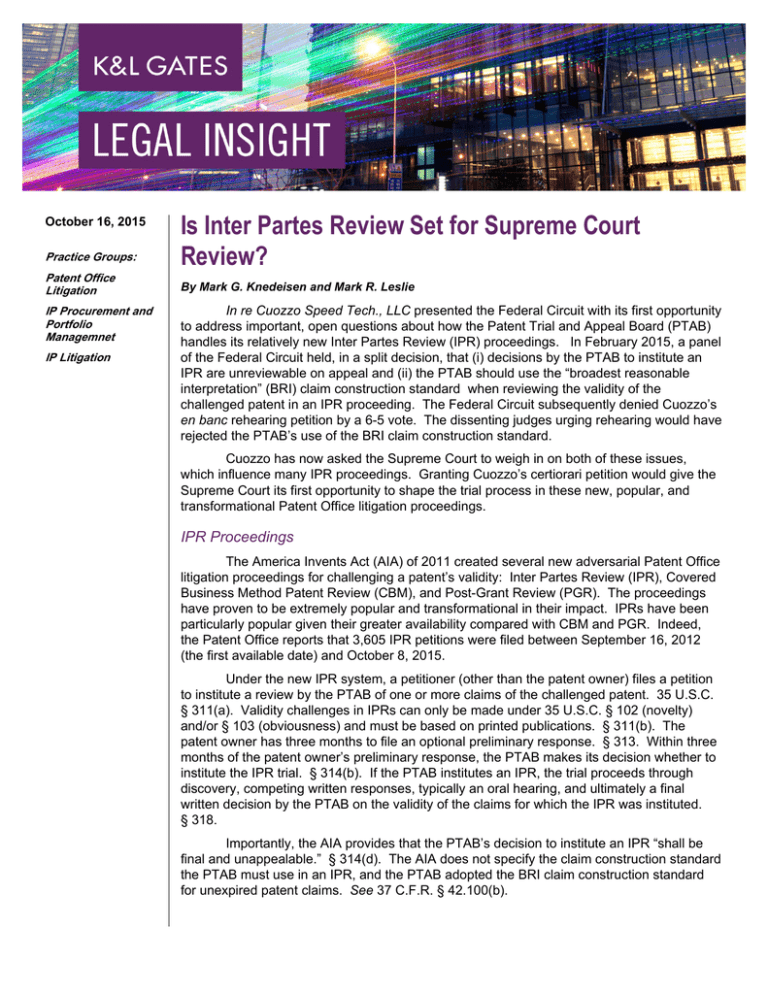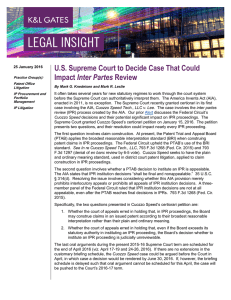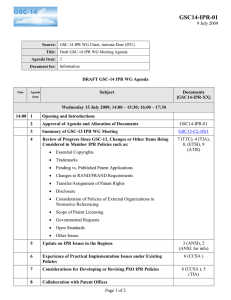
October 16, 2015
Practice Groups:
Patent Office
Litigation
IP Procurement and
Portfolio
Managemnet
IP Litigation
Is Inter Partes Review Set for Supreme Court
Review?
By Mark G. Knedeisen and Mark R. Leslie
In re Cuozzo Speed Tech., LLC presented the Federal Circuit with its first opportunity
to address important, open questions about how the Patent Trial and Appeal Board (PTAB)
handles its relatively new Inter Partes Review (IPR) proceedings. In February 2015, a panel
of the Federal Circuit held, in a split decision, that (i) decisions by the PTAB to institute an
IPR are unreviewable on appeal and (ii) the PTAB should use the “broadest reasonable
interpretation” (BRI) claim construction standard when reviewing the validity of the
challenged patent in an IPR proceeding. The Federal Circuit subsequently denied Cuozzo’s
en banc rehearing petition by a 6-5 vote. The dissenting judges urging rehearing would have
rejected the PTAB’s use of the BRI claim construction standard.
Cuozzo has now asked the Supreme Court to weigh in on both of these issues,
which influence many IPR proceedings. Granting Cuozzo’s certiorari petition would give the
Supreme Court its first opportunity to shape the trial process in these new, popular, and
transformational Patent Office litigation proceedings.
IPR Proceedings
The America Invents Act (AIA) of 2011 created several new adversarial Patent Office
litigation proceedings for challenging a patent’s validity: Inter Partes Review (IPR), Covered
Business Method Patent Review (CBM), and Post-Grant Review (PGR). The proceedings
have proven to be extremely popular and transformational in their impact. IPRs have been
particularly popular given their greater availability compared with CBM and PGR. Indeed,
the Patent Office reports that 3,605 IPR petitions were filed between September 16, 2012
(the first available date) and October 8, 2015.
Under the new IPR system, a petitioner (other than the patent owner) files a petition
to institute a review by the PTAB of one or more claims of the challenged patent. 35 U.S.C.
§ 311(a). Validity challenges in IPRs can only be made under 35 U.S.C. § 102 (novelty)
and/or § 103 (obviousness) and must be based on printed publications. § 311(b). The
patent owner has three months to file an optional preliminary response. § 313. Within three
months of the patent owner’s preliminary response, the PTAB makes its decision whether to
institute the IPR trial. § 314(b). If the PTAB institutes an IPR, the trial proceeds through
discovery, competing written responses, typically an oral hearing, and ultimately a final
written decision by the PTAB on the validity of the claims for which the IPR was instituted.
§ 318.
Importantly, the AIA provides that the PTAB’s decision to institute an IPR “shall be
final and unappealable.” § 314(d). The AIA does not specify the claim construction standard
the PTAB must use in an IPR, and the PTAB adopted the BRI claim construction standard
for unexpired patent claims. See 37 C.F.R. § 42.100(b).
Is Inter Partes Review Set for Supreme Court Review?
The IPR of Cuozzo’s Patent
Cuozzo sued Garmin International for infringement of U.S. Patent No. 6,778,074
(“the ‘074 Patent”) on June 15, 2012, in the United States District Court for the District of
New Jersey. In response, Garmin filed an IPR petition for the ‘074 Patent on September 16,
2012, the first possible filing date for IPR petitions. The PTAB instituted the IPR on January
9, 2013, although it did not do so on the exact grounds Garmin requested.
The ‘074 Patent is directed to a speed limit indicator for a motor vehicle that displays
both the current speed of the vehicle and the applicable speed limit, which is determined with
the aid of a GPS system. The applicable speed limit is shown in a “colored display,” and the
speedometer is “integrally attached” to the colored display. The validity of the challenged
claims turned on the meaning of the claim term “integrally attached.” In its final written
decision, the PTAB construed this term using the BRI standard to mean “discrete parts
physically joined together as a unit without each part losing its own separate identity.” This
construction was broader than Cuozzo’s proposed construction, which was “joined or
combined to work as a complete unit.” In rejecting Cuozzo’s proposed construction, the
PTAB remarked that “Cuozzo’s arguments are directed to an ‘integral display’ rather than a
speedometer that it ‘integrally attached’ to a colored display,” as actually recited in the claim.
The PTAB’s determined that the challenged claims were invalid under its adopted
construction.
The Federal Circuit Appeal
Cuozzo appealed the PTAB’s final written decision to the Federal Circuit. The
appeal presented two main issues: (1) whether the AIA’s prohibition on appeals of IPR
institution decisions prohibits interlocutory appeals while permitting appeals of the institution
decision following the PTAB’s final written decision; and (2) the appropriate claim
construction standard for IPRs. Cuozzo argued that the institution was improper because
the PTAB did not adopt the exact grounds presented in Garmin’s IPR petition, in
contravention of the AIA’s requirement that the petition “identif[y] … with particularity … the
grounds on which the challenge to each claim is based ….” 35 U.S.C. § 312(a)(3).
A three-judge Federal Circuit panel affirmed the PTAB’s cancellation of the
challenged claims in a February 4, 2015 decision in which the judges split 2–1. 778 F.3d
1271. It subsequently withdrew that opinion and issued a slightly amended one on July 8,
2015. 793 F.3d 1268. Judges Dyk and Clevenger concluded that the AIA’s prohibition on
appeals (35 U.S.C. § 314(d)) means what it says: institution decisions are not appealable
even after a final decision of the PTAB. The majority’s reasoning centered on two key
factors. First, the AIA statute expressly states that institution decisions are “final,” which
suggests more than a mere prohibition on interlocutory appeals. Second, another provision
of the AIA, § 319, specifies that “the final written decision” of the PTAB can be appealed,
without mentioning that institution decisions can be appealed. 793 F.3d at 1273. The
majority intimated that in certain circumstances a mandamus petition could be used to review
a PTAB institution decision, but since Cuozzo did not seek mandamus the Federal Circuit
1
had no reason to decide the issue. Id. at 1274–75.
1
Nevertheless, the majority stated that Cuozzo’s situation “is far from satisfying the clear-and-indisputable
requirement for mandamus.” Id. at 1275.
2
Is Inter Partes Review Set for Supreme Court Review?
The panel majority also agreed with the PTAB that the BRI standard must be applied
in IPRs. Again, the majority’s reasoning was based on two key considerations. First, since
Congress did not specify the applicable standard, and given the PTO’s long-standing use of
the BRI standard in traditional examination and reexamination contexts, Congress must have
intended the BRI standard to apply. Id. at 1276–77. The majority reasoned that a patent
owner’s ability to amend claims in IPR further supported application of the BRI standard,
although the majority admitted that the ability to amend claims is “cabined in the IPR setting.”
Id. at 1278. Second, the majority found that the PTO had rulemaking authority to adopt the
BRI standard under §316(a)(2) and § 316(a)(4), which states that the PTAB can “prescribe
regulations” for the IPR institution standard and trial process, and that the PTAB decision to
2
use BRI was entitled to Chevron deference. Id. at 1279.
Judge Newman dissented on both issues, arguing that the twin rulings from the panel
majority “thwart” Congress’s statutory plan for providing “quick and cost effective alternatives
to litigation.” Id. at 1284 (quoting AIA legislative history at 2011 U.S.C.C.A.N. 67, 78).
Regarding claim construction, Judge Newman wrote that AIA trials are designed to reach
“the same correct result as in the district courts.” Id. at 1285. As such, she argued, IPRs
should use the same claim construction standard as in a district court, especially since a
claim must be construed in the same way for validity and infringement, the latter of which is
adjudicated in district courts and not by the PTAB. Id. at 1286. She further argued that,
unlike IPRs, the prosecution of patent applications “is a fluid exchange between the
examiner and the applicant,” and the BRI standard is an “examination expedient” used in this
context given the applicant’s right to amend the claims. Id. at 1287. In contrast, according to
Judge Newman, the right to amend claims in an IPR is “almost entirely illusory.” Id. at 1288.
She asserted that the AIA only provided the PTAB with rulemaking authority as to IPR trial
procedure, and not the authority “to change the law of how claims of issued patents are
construed.” Id. at 1290. Finally, she argued that § 314(d)’s prohibition on appeals only
prohibits interlocutory appeals before a final decision.
The Federal Circuit denied Cuozzo’s en banc rehearing petition in a razor-thin 6–5
vote. 793 F.3d 1297. The close vote appears to reflect significant internal disagreement on
the proper claim construction standard. Judge Dyk issued an opinion, joined by Judges
Lourie, Chen and Hughes, concurring in the denial and echoing the panel’s majority decision
upholding the BRI standard. Judge Dyk also noted that pending Congressional legislation
would change the claim construction standard for AIA trials, confirming that Congress
intended the PTAB to promulgate the standard under the original AIA legislation. Id. at
3
1299.
Chief Judge Prost and Judge Newman each issued an opinion dissenting from denial
of en banc review. Chief Judge Prost’s opinion, joined by Judges Newman, Moore, O’Malley
and Reyna, attacked the logic of the panel majority, making four main points. First,
2
According to Chevron, U.S.A. v. Natural Res. Def. Council, Inc., 467 U.S. 837 (1984), courts should defer
to agency interpretations of statutes that mandate the agency take some action unless the agency’s
interpretation is unreasonable.
3
Judge Dyk cited: Innovation Act, H.R. 9, 114th Cong. § 9(b)(1)(C) (2015) (as reported by House Judiciary
Committee on June 11, 2015, with Manager’s Amendment in the nature of a substitute); PATENT Act, S.
1137, 114th Cong. § 11(a)(4)(A)(vii) (2015) (as reported by Senate Judiciary Committee on June 4, 2015,
with Manager’s Amendment in the nature of a substitute); STRONG Patents Act of 2015, S. 632, 114th
Cong. § 102(a) (2015) (as introduced on March 3, 2015).
3
Is Inter Partes Review Set for Supreme Court Review?
Congress’s silence on the claim construction standard did not implicitly adopt the longstanding BRI standard since AIA trials were brand-new proceedings, and Congress “was not
legislating within an already existing regime.” Id. at 1300. Second, she argued that the
background of existing law shows that the BRI standard is inappropriate, since it is a “useful
tool, prior to patent issuance.” Id. (emphasis in original). IPRs are akin to district court
litigation since “there is no robust right to amend” claims, according to Chief Judge Prost,
and a similar claim construction standard should apply. Id. at1301. Chief Judge Prost also
disagreed that Congress gave rulemaking authority to the PTAB on the issue. She noted
that the provisions the panel majority cites as providing the PTAB this authority, §§316(2)
and (4), relate to procedural issues, and not substantive legal issues like claim construction,
which affect decisions to institute an IPR. She further argued that even if Congress gave the
PTAB authority to adopt a claim construction standard, the PTAB’s adoption of the BRI
standard is not entitled to deference since it defeats Congress’s intent that IPRs substitute
for district court litigation. Id. at 1302–03.
Judge Newman’s dissenting opinion reviewed several amicus briefs that, in her view,
uniformly support the position that the PTAB should apply the Phillips claim construction
standard. She remarked that the “loser in this debate is the nation, for the ambitious plan of
the America Invents Act is thwarted….” Id. at 1304.
Supreme Court Prospects
On October 6, 2015, Cuozzo petitioned for Supreme Court review on both the
appealability of IPR institution decisions and whether the PTAB should apply the BRI
standard. These issues impact many IPRs and will continue to generate uncertainty until the
Supreme Court rules on them. Arguably, the closely contested panel and en banc review
decisions at the Federal Circuit demonstrate the circuit court “split” the Supreme Court often
considers significant when deciding whether to take a case. See e.g., Alice Corp. v. CLS
Bank, 134 S. Ct. 2347 (2014) (Supreme Court granted certiorari after divisive split at Federal
Circuit). Despite that fact, the rate at which the Supreme Court accepts cases for review is
very low, and it is fair to say that it is unlikely to take the case.
Nevertheless, if not in Cuozzo, we expect—absent Congressional intervention—that
the Supreme Court eventually will address both the appealability and claim construction
issues for IPRs. In the meantime, parties to an IPR in which the claim construction standard
affects the outcome should carefully consider taking steps to preserve the right to argue that
the BRI standard should not be applied.
Authors:
Mark G. Knedeisen
Mark R. Leslie
mark.knedeisen@klgates.com
+1. 412.355.6342
mark.leslie@klgates.com
+1.412.355.6501
4
Is Inter Partes Review Set for Supreme Court Review?
Anchorage Austin Beijing Berlin Boston Brisbane Brussels Charleston Charlotte Chicago Dallas Doha Dubai Fort Worth Frankfurt
Harrisburg Hong Kong Houston London Los Angeles Melbourne Miami Milan Moscow Newark New York Orange County Palo Alto Paris
Perth Pittsburgh Portland Raleigh Research Triangle Park San Francisco São Paulo Seattle Seoul Shanghai Singapore Spokane
Sydney Taipei Tokyo Warsaw Washington, D.C. Wilmington
K&L Gates comprises more than 2,000 lawyers globally who practice in fully integrated offices located on five
continents. The firm represents leading multinational corporations, growth and middle-market companies, capital
markets participants and entrepreneurs in every major industry group as well as public sector entities, educational
institutions, philanthropic organizations and individuals. For more information about K&L Gates or its locations,
practices and registrations, visit www.klgates.com.
This publication is for informational purposes and does not contain or convey legal advice. The information herein should not be used or relied upon in
regard to any particular facts or circumstances without first consulting a lawyer.
© 2015 K&L Gates LLP. All Rights Reserved.
5



